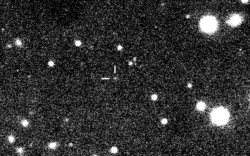Astronomy:Pasithee (moon)
 Discovery images of Pasithee by the Canada-France-Hawaii Telescope in December 2001 | |
| Discovery [1] | |
|---|---|
| Discovered by | Scott S. Sheppard David C. Jewitt Jan T. Kleyna |
| Discovery site | Mauna Kea Observatory |
| Discovery date | 11 December 2001 |
| Designations | |
Designation | Jupiter XXXVIII |
| Pronunciation | /ˈpæsəθiː/ |
| Named after | Πασιθέα Pāsithea |
| S/2001 J 6 | |
| Adjectives | Pasithean[2] /pəˈsɪθiən/[3] |
| Orbital characteristics [4] | |
| Epoch 17 December 2020 (JD 2459200.5) | |
| Observation arc | 16.29 yr (5,949 days) |
| 0.1535315 astronomical unit|AU (22,967,990 km) | |
| Eccentricity | 0.2097026 |
| Orbital period | –711.12 d |
| Mean anomaly | 71.98760° |
| Mean motion | 0° 30m 22.488s / day |
| Inclination | 164.72796° (to ecliptic) |
| Longitude of ascending node | 49.07994° |
| 331.51895° | |
| Satellite of | Jupiter |
| Group | Carme group |
| Physical characteristics[6] | |
| Mean diameter | 2 km |
| Albedo | 0.04 (assumed) |
| Apparent magnitude | 23.2[5] |
| Absolute magnitude (H) | 16.8[4] |
Pasithee /ˈpæsəθiː/, also known as Jupiter XXXVIII, is a retrograde irregular satellite of Jupiter. It was discovered by a team of astronomers from the University of Hawaii led by Scott S. Sheppard in 2001, and given the temporary designation S/2001 J 6.[7][1]
Pasithee is about 2 kilometres in diameter, and orbits Jupiter at an average distance of 23,307,000 km in 711.12 days, at an inclination of 166° to the ecliptic (164° to Jupiter's equator), in a retrograde direction and with an eccentricity of 0.3289.
It was named in August 2003 after Pasithee, one of the Charites, goddesses of charm, beauty, nature, human creativity and fertility, daughters of Zeus (Jupiter) by Eurynome.[8] Pasithee, better known as Aglaea, is the spouse of Hypnos (Sleep) and presides over hallucinations and hallucinogens.
It belongs to the Carme group, made up of irregular retrograde moons orbiting Jupiter at a distance ranging between 23 and 24 Gm and at an inclination of about 165°.
References
- ↑ 1.0 1.1 MPEC 2002-J54: Eleven New Satellites of Jupiter May 15, 2002 (discovery and ephemeris)
- ↑ Sheila Dillon (1996) "The portraits of a civic benefactor of 2nd-c. Ephesos", Journal of Roman Archaeology, p. 273
- ↑ per 'Pasithea' in Noah Webster (1884) A Practical Dictionary of the English Language and "Pasithea". Dictionary.com Unabridged. Random House. https://www.dictionary.com/browse/Pasithea.
- ↑ 4.0 4.1 "M.P.C. 127088". Minor Planet Circular. Minor Planet Center. 17 November 2020. https://minorplanetcenter.net/iau/ECS/MPCArchive/2020/MPC_20201117.pdf.
- ↑ Sheppard, Scott. "Scott S. Sheppard - Jupiter Moons". Department of Terrestrial Magnetism. Carnegie Institution for Science. https://sites.google.com/carnegiescience.edu/sheppard/moons/jupitermoons.
- ↑ "Planetary Satellite Physical Parameters". Jet Propulsion Laboratory. 19 February 2015. https://ssd.jpl.nasa.gov/?sat_phys_par#jupiter.
- ↑ IAUC 7900: Satellites of Jupiter May 16, 2002 (discovery)
- ↑ IAUC 8177: Satellites of Jupiter, Saturn, Uranus 2003 August (naming the moon)
 |

